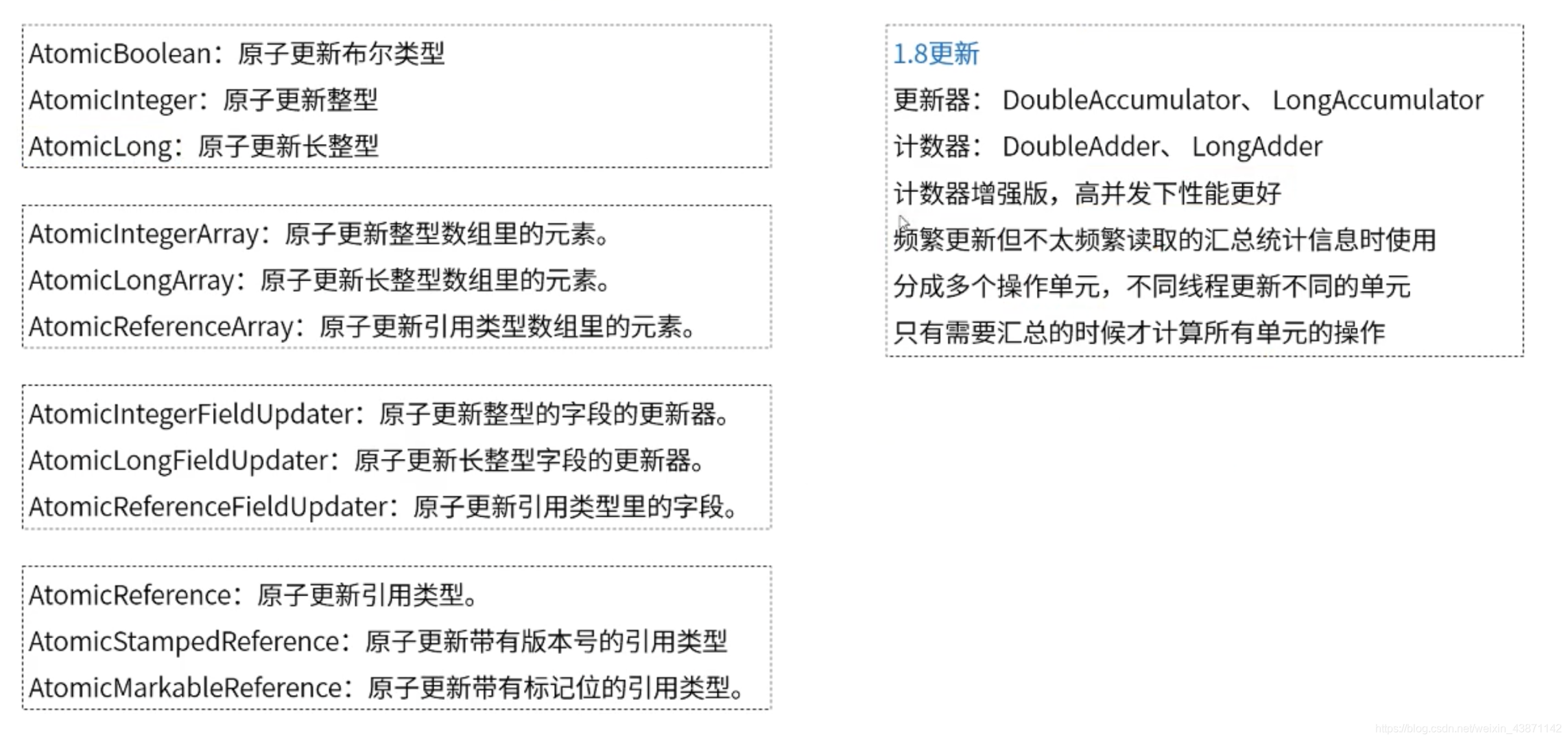竞态条件与临界区
public class Demo{
public int i = 0;
public void incr(){
i++;
}
}
多个线程访问了相同的资源,向这些资源做了写操作时,对执行顺序有要求。
临界区: incr 方法内部就是临界区域,关键部分代码的多线程并发执行,会对执行结果产生影响。
竞态条件: 可能发生在临界区域内的特殊条件。多线程执行incr 方法中的 i++ 关键代码时,产生了竞态条件。
共享资源
- 如果一段代码是线程安全的,则它不包含竞态条件。只有当多个线程更新共享资源时,才会发生竞态条件。
- 栈封闭时,不会在线程之间共享的变量,都是线程安全的。
- 局部对象引用本身不共享,但是引用的对象存储在共享堆中。如果方法内创建的对象,只是在方法中传递,并且不对其他线程可用,那么也是线程安全的。
public void someMethod(){
LocalObject localObject = new LocalObject();
localObject.callMethod();
method2(localObject);
}
public void method2(LocalObject localObject){
localObject.setValue("value");
}
判断规则:如果创建、使用和处理资源,永远不会逃脱单个线程的控制,该资源的使用是线程安全的。
不可变对象
创建不可变的共享对象在线程间共享时不会被修改,从而实现线程安全。
实例被创建,value变量就不能再被修改,这就是不可变性。
public class Demo{
private int value = 0;
public Demo(int value){
this.value = value;
}
public int getValue(){
return this.value;
}
//不提供对象内属性的设置方法
}
原子操作定义
原子操作可以是一个步骤,也可以是多个操作步骤,但是其顺序不可以被打乱,也不可以被切割而只执行其中的一部分(不可中断性)。
将整个操作视作一个整体是原子性的核心特征。
public class Demo{
public int i = 0;
public void incr(){
i++; //进行i++的步骤实际分为三步:1. 加载i 2.计算+i 3.赋值
}
public static void main(String[] args) throws InterruptedException {
Demo ld = new Demo();
for (int i = 0; i < 2; i++) {
new Thread(() -> {
for (int j = 0; j < 10000; j++) {
ld.incr();
}
}).start();
}
Thread.sleep(2000L);
System.out.println(ld.i);
}
}
结果输出后你会发现i的值不为20000,就是因为进行i++的步骤实际分为三步,不为原子性操作。
CAS机制
Compare and swap比较和交换。属于硬件同步原语,**处理器提供基本内存操作的原子性保证。**CAS操作需要输入两个数值,一个旧值(期望操作前的值)和一个新值,在操作期间先比较下旧值有没有发生变化,如果没有发生变化,才交换新值,发生了变化则不交换。
Java中的sun.misc.Unsafe类,提供了compareAndSwapInt()和compareAndSwapLong()等几个方法实现CAS。
public class LockDemo1 {
volatile int value = 0;
static Unsafe unsafe;//直接操控内存,修改对象,数组内存...强大的API
private static long valueOffset;//偏移量
static {
try {
// 反射技术获取unsafe值
Field field = Unsafe.class.getDeclaredField("theUnsafee");
field.setAccessible(true);
unsafe = (Unsafe)field.get(null);
// 获取到 value 属性偏移量(用于定于value属性在内存中的具体地址)
valueOffset = unsafe.objectFieldOffset(LockDemo1.class
.getDeclaredField("value"));
} catch (Exception e) {
e.printStackTrace();
}
}
public void add() {
// TODO xx00
// i++;// JAVA 层面三个步骤
// CAS + 循环 重试
int current;
do {
// 操作耗时的话, 那么 线程就会占用大量的CPU执行时间
current = unsafe.getIntVolatile(this, valueOffset);
} while (!unsafe.compareAndSwapInt(this, valueOffset, current, current + 1));
// 可能会失败
}
public static void main(String[] args) throws InterruptedException {
LockDemo1 ld = new LockDemo1();
for (int i = 0; i < 2; i++) {
new Thread(() -> {
for (int j = 0; j < 10000; j++) {
ld.add();
}
}).start();
}
Thread.sleep(2000L);
System.out.println(ld.value);
}
}
输出结果:20000
当然我们只需要理解其中的原理,JDK给我们准备了现成的API。
保证原子操作的其他方法
- 利用synchronized
public class LockDemo2 {
int i = 0;
public void add() {
synchronized (this) {
i++;
}
}
public static void main(String[] args) throws InterruptedException {
LockDemo2 ld = new LockDemo2();
for (int i = 0; i < 2; i++) {
new Thread(() -> {
for (int j = 0; j < 10000; j++) {
ld.add();
}
}).start();
}
Thread.sleep(2000L);
System.out.println(ld.i);
}
}
输出结果:20000
- 利用Lock
public class LockDemo3 {
volatile int i = 0;
Lock lock = new ReentrantLock();
public void add() {
lock.lock();
try {
// TODO 很多业务操作
i++;
}finally {
lock.unlock();
}
}
public static void main(String[] args) throws InterruptedException {
LockDemo3 ld = new LockDemo3();
for (int i = 0; i < 20; i++) {
new Thread(() -> {
for (int j = 0; j < 10000; j++) {
ld.add();
}
}).start();
}
Thread.sleep(2000L);
System.out.println(ld.i);
}
}
输出结果:20000
J.U.C包内的原子操作封装类
// atomic 相关测试代码
public class AtomicTest {
public static void main(String[] args) throws InterruptedException {
// 自增
AtomicInteger atomicInteger = new AtomicInteger(0);
for (int i = 0; i < 2; i++) {
new Thread(() -> {
for (int j = 0; j < 10000; j++) {
atomicInteger.incrementAndGet();
}
}).start();
}
Thread.sleep(2000L);
System.out.println(atomicInteger.get());
}
}
// LongAccumulator是LongAdder增强版,处理累加之外,可以自行定义其他计算
public class LongAccumulatorDemo {
public static void main(String[] args) throws InterruptedException {
LongAccumulator accumulator = new LongAccumulator(new LongBinaryOperator() {
@Override
public long applyAsLong(long left, long right) {
// 返回最大值,这就是自定义的计算
return left < right ? left : right;
}
}, 0);
// 1000个线程
for (int i = 0; i < 1000; i++) {
int finalI = i;
new Thread(() -> {
accumulator.accumulate(finalI); // 此处实际就是执行上面定义的操作
}).start();
}
Thread.sleep(2000L);
System.out.println(accumulator.longValue()); // 打印出结果
}
}
synchronized、AtomicLong和LongAdder三者的性能比较
// 测试用例: 同时运行2秒,检查谁的次数最多
public class LongAdderDemo {
private long count = 0;
// 同步代码块的方式
public void testSync() throws InterruptedException {
for (int i = 0; i < 3; i++) {
new Thread(() -> {
long starttime = System.currentTimeMillis();
while (System.currentTimeMillis() - starttime < 2000) { // 运行两秒
synchronized (this) {
++count;
}
}
long endtime = System.currentTimeMillis();
System.out.println("SyncThread spend:" + (endtime - starttime) + "ms" + " v" + count);
}).start();
}
}
// Atomic方式
private AtomicLong acount = new AtomicLong(0L);
public void testAtomic() throws InterruptedException {
for (int i = 0; i < 3; i++) {
new Thread(() -> {
long starttime = System.currentTimeMillis();
while (System.currentTimeMillis() - starttime < 2000) { // 运行两秒
acount.incrementAndGet(); // acount++;
}
long endtime = System.currentTimeMillis();
System.out.println("AtomicThread spend:" + (endtime - starttime) + "ms" + " v-" + acount.incrementAndGet());
}).start();
}
}
// LongAdder 方式
private LongAdder lacount = new LongAdder();
public void testLongAdder() throws InterruptedException {
for (int i = 0; i < 3; i++) {
new Thread(() -> {
long starttime = System.currentTimeMillis();
while (System.currentTimeMillis() - starttime < 2000) { // 运行两秒
lacount.increment();
}
long endtime = System.currentTimeMillis();
System.out.println("LongAdderThread spend:" + (endtime - starttime) + "ms" + " v-" + lacount.sum());
}).start();
}
}
public static void main(String[] args) throws InterruptedException {
LongAdderDemo demo = new LongAdderDemo();
demo.testSync();
demo.testAtomic();
demo.testLongAdder();
}
}
输出结果:
SyncThread spend:2000ms v22957789
AtomicThread spend:2000ms v-36239545
AtomicThread spend:2000ms v-36309497
SyncThread spend:2007ms v22957790
AtomicThread spend:2004ms v-36332774
SyncThread spend:2015ms v22957791
LongAdderThread spend:2000ms v-40279545
LongAdderThread spend:2000ms v-40835325
LongAdderThread spend:2000ms v-40855171
由此可以看出在相同时间内三个方法同时累加并且互相争抢CPU的性能,最终运行结果是LongAdder在两秒运行次数最多。
